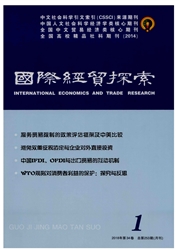

 中文摘要:
中文摘要:
通过把Grossman and Helpman(1994)模型扩展到多区域、多产业框架,并引入区域贸易一体化因素,从理论视角分析了FDI对出口贸易的影响机制.并聚焦于区域贸易协定在这种影响机制中的作用。理论分析结果表明,FDI流入以非线性方式影响出口。影响机制不仅与本国的市场规模、资本存量、本国与其他经济体的贸易自由度相关,还与贸易伙伴的市场规模和彼此之间的贸易自由度相关。贸易自由度在FDI影响贸易的机制中具有“二次放大”效应。此结论在使用1986~2010年跨国面板数据所进行的实证研究中得到证明。该结果意味着在当前国际经济、外贸形势下,中国与东亚主要经济体尤其是日本、韩国加快谈判进程,提高贸易便利化水平,对推动我国外贸发展,降低欧盟、美国对我国“贸易包围圈”的不利影响有重要意义。
 英文摘要:
英文摘要:
In the context of regional integration, does the inflow FDI from EU and East Asia have a trade creation or trade substitution effect on China? By developing a theoretical multi-regional spatial equilibrium model and making an empirical panel data analysis, this paper empirically examines the relationship between Sino-EU trade and FDI in the framework of new trade theory. The main results reveal the evidence of a nonlinear effect between FDI and trade. In addition, trade liberalization is found to have an important role.
 同期刊论文项目
同期刊论文项目
 同项目期刊论文
同项目期刊论文
 期刊信息
期刊信息
